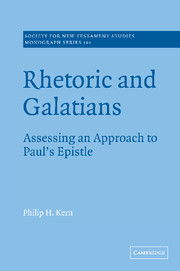Book contents
- Frontmatter
- Contents
- Preface
- List of abbreviations
- 1 Introduction
- 2 Towards a definition of rhetoric
- 3 Methods of rhetorical analysis and Galatians
- 4 Rhetorical structure and Galatians
- 5 Rhetorical species and Galatians
- 6 The language of Paul's letters: 1. As evaluated by early Christian writers
- 7 The language of Paul's letters: 2. The contribution of modern studies
- 8 Conclusions
- Select bibliography
- Index of subjects
- Index of modern authors
- Society for New Testament Studies
7 - The language of Paul's letters: 2. The contribution of modern studies
Published online by Cambridge University Press: 22 September 2009
- Frontmatter
- Contents
- Preface
- List of abbreviations
- 1 Introduction
- 2 Towards a definition of rhetoric
- 3 Methods of rhetorical analysis and Galatians
- 4 Rhetorical structure and Galatians
- 5 Rhetorical species and Galatians
- 6 The language of Paul's letters: 1. As evaluated by early Christian writers
- 7 The language of Paul's letters: 2. The contribution of modern studies
- 8 Conclusions
- Select bibliography
- Index of subjects
- Index of modern authors
- Society for New Testament Studies
Summary
Acts 24: a courtroom analogy
William Kurz in discussing Paul's defence before Felix in Acts 24 declares that ‘Luke's ability to give the appearance of a full speech is striking to a modern reader, and comparable to that of the classical and Hellenistic historians'. Fred Veltman adds that the speech exhibits ‘all the earmarks of a typical apology’. Kurz concludes that to identify a Lukan awareness of the rules of Greek rhetoric is simply to ‘argue from observable effects to their required cause’.
It is commonly agreed that Acts 24 contains a court-scene and that Luke provides touches which give the account an air of authenticity. But what is it that stimulates such a response in the reader? And more to the point: do those same factors which evoke the forensic atmosphere fill the Galatian air? We will develop this analogy by isolating the elements which transport the reader into a forensic setting. If kept brief enough to avoid becoming a distraction, isolating such elements can contribute to our understanding of the task which confronts the writer intent upon creating a fictitious piece of forensic discourse: Paul's supposed purpose in Galatians.
The creation of context is assisted by the narrative introduction – those elements which at the outset determine the atmosphere of the scene. In accordance with the standard practice as revealed in ancient court records, we are told in Acts that the accusors arrive acompanied by a ‘rhetor’. Luke, following custom, employs the genitive absolute to introduce the dispute.
- Type
- Chapter
- Information
- Rhetoric and GalatiansAssessing an Approach to Paul's Epistle, pp. 204 - 255Publisher: Cambridge University PressPrint publication year: 1998



